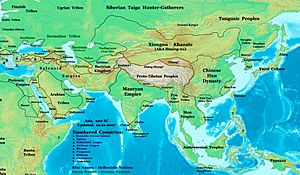Sa Huỳnh culture facts for kids
The Sa Huỳnh culture was an ancient civilization that lived in what is now central and southern Vietnam. This culture was active for a long time, from about 1000 BC to 200 AD. We have found many places where the Sa Huỳnh people lived, stretching from the Mekong Delta all the way to Quảng Bình province in central Vietnam. It is believed that the Sa Huỳnh people were the ancestors of the Cham people. The Cham people speak an Austronesian language and later founded the kingdom of Champa.
Contents
What Was the Sa Huỳnh Culture Like?
The first Sa Huỳnh site was discovered in 1909. These sites are special because they have many tools and items made from iron. You can find things like axes, swords, spearheads, knives, and sickles. This is different from the Đông Sơn culture in northern Vietnam, where most tools were made of bronze.
The Sa Huỳnh people had a unique way of burying their dead. They would cremate adults and then place their ashes and bones inside large jars. These jars were covered with lids. They also often put special offerings, which were usually broken, next to the jar burials.
Another unique thing about the Sa Huỳnh culture is their ear ornaments. These ornaments often showed two-headed animals. Some people think these animals might have been the saola, a rare animal found in Vietnam. These ornaments were mostly made from a type of jade called nephrite, but some were also made from glass. They also wore many bead ornaments, often made of glass.
How the Sa Huỳnh People Traded
The Sa Huỳnh culture was part of a huge trading network. This network existed for a very long time, from about 500 BC to 1500 AD. It is known as the Sa Huynh-Kalanay Interaction Sphere. This name comes from the Sa Huỳnh culture and the Kalanay Cave in the Philippines.
This trade network mostly connected Sa Huỳnh with the Philippines. But it also reached other places like Taiwan, Southern Thailand, and northeastern Borneo. People in this network shared similar styles of red-colored pottery. They also shared special ornaments called lingling-o. These were often double-headed or shaped like a C.
These lingling-o ornaments were made from different materials. Green jade came from Taiwan. Green mica came from Mindoro. Black nephrite came from Hà Tĩnh in Vietnam. And clay was used from Vietnam and the Northern Philippines. The Sa Huỳnh people also made beads from many materials like glass, carnelian, agate, olivine, zircon, gold, and garnet. Many of these materials were also imported from other places. Even Han dynasty-style bronze mirrors have been found at Sa Huỳnh sites, showing how far their trade reached.
The Iron Age in the Region
The Sa Huỳnh culture existed during a period known as the Iron Age. This was a time when people started using iron to make tools and weapons instead of bronze. The Sa Huỳnh culture was a key part of the Iron Age in Southeast Asia.
Artifacts
See also
- Austronesian peoples
- Plain of Jars
- Cát Tiên sanctuary
- Óc Eo
- Champa
- Buni culture
- Tabon Caves








